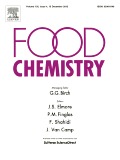Redox effect on volatile compound formation in wine during fermentation by Saccharomyces cerevisiae
Dublin Core
Título
Tema
Abstract
Although redox state is a well-known key process parameter in microbial activity, its impact on wine volatile aroma compounds produced during fermentation has not been studied in detail. In this study we report the effect of reductive and microaerobic conditions on wine aroma compound production using different initial amounts of yeast assimilable nitrogen (YAN: 180 and 400 mg N/l) in a simil grape must defined medium and two S. cerevisiae strains commonly used in wine-making. In batch fermentation culture conditions, reductive conditions were obtained using flasks plugged with Muller valves filled with sulphuric acid; while microaerobic conditions were attained with defined cotton plugs. It was found that significant differences in redox potential were obtained using the different plugs, and with variation of over 100 mV during the main fermentation period. Significant differences in the final concentration of higher alcohols, esters and fatty acids were attributed to differences in the redox state in the medium in both strains. A consistent increase in esters and medium chain fatty acids, as well as a decrease of higher alcohols and isoacids, was seen under reductive fermentation conditions. Interestingly, 1-propanol, d-butyrolactone and ethyl lactate concentrations, showed no significant variation under the different redox conditions. A better understanding of the influence of redox state of the fermentation medium on the composition of volatile compounds in wine could enable improvement of vinification management. From a microbiological standpoint results presented here will contribute to the standardization of data models for the application of metabolic footprinting methods for wine yeast strain phenotyping and characterization
Fuente
Editor
Fecha
Derechos
Información sobre Derechos de Autor
(Por favor lea este aviso antes de abrir los documentos u objetos)
La legislación uruguaya protege el derecho de autor sobre toda creación literaria, científica o artística, tanto en lo que tiene que ver con sus derechos morales, como en lo referente a los derechos patrimoniales con sujeción a lo establecido por el derecho común y las siguientes leyes
(LEY 9.739 DE 17 DE DICIEMBRE DE 1937 SOBRE PROPIEDAD LITERARIA Y ARTISTICA CON LAS MODIFICACIONES INTRODUCIDAS POR LA LEY DE DERECHO DE AUTOR Y DERECHOS CONEXOS No. 17.616 DE 10 DE ENERO DE 2003, LEY 17.805 DE 26 DE AGOSTO DE 2004, LEY 18.046 DE 24 DE OCTUBRE DE 2006 LEY 18.046 DE 24 DE OCTUBRE DE 2006)
ADVERTENCIA - La consulta de este documento queda condicionada a la aceptación de las siguientes condiciones de uso: Este documento es únicamente para usos privados enmarcados en actividades de investigación y docencia. No se autoriza su reproducción con fines de lucro. Esta reserva de derechos afecta tanto los datos del documento como a sus contenidos. En la utilización o cita de partes debe indicarse el nombre de la persona autora.
Formato
Idioma
Tipo
Identificador
Document Item Type Metadata
Original Format
- Fecha de agregación
- October 2, 2012
- Colección
- Bibliografía Nacional Química
- Tipo de Elemento
- Document
- Etiquetas
- Fermentación, Levaduras, Saccharomyces cerevisiae, Vino
- Citación
- Fariña, Laura, “Redox effect on volatile compound formation in wine during fermentation by Saccharomyces cerevisiae,” RIQUIM - Repositorio Institucional de la Facultad de Química - UdelaR, accessed July 26, 2024, https://riquim.fq.edu.uy/items/show/178.
- Archivos

